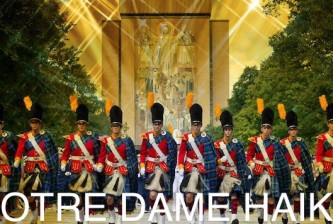A couple of weeks ago, I wrote a piece on Notre Dame’s offense and the use of multiple-tight end formations. In case you missed it, you can read it here. Now that I’ve had the opportunity to rewatched the Blue and Gold Game, I thought I’d breakdown a few plays to illustrate how the coaching staff will use their tight ends to create mismatches this fall.
The first play is Ben Koyack’s touchdown. It’s a good example of how dangerous tight ends can be in the red zone.
The offense lines up in an Ace formation with Alex Welch and Ben Koyack on either end of the line and twin receivers to the wide side of the field. The defense aligns in a base 3-4 with safety Austin Collinsworth lined up over the slot.

Just before the snap, Collinsworth shows blitz while the other safety, Chris Salvi, rotates from the right hash toward the center of the field. The single-high safety look is a pretty good indicator that the defense is playing Cover 1 or Cover 3. Either way, Koyack’s corner route will isolate him against Josh Atkinson.

The line neutralizes the rush while Golson rolls to his right. With Salvi covering the wide side of the field, the 5-11, 185 lb Atkinson is left on an island covering the 6-5, 253 lb Koyack. Atkinson is giving up 6 inches and nearly 70 lbs.

Once Koyack breaks for the corner, all Golson has to do is throw it up and let Koyack use his body to shield the defender. Atkinson never gets between Koyack and the ball, and the result is an easy score. Atkinson made some good plays during the game and has a bright future, but this match up favors the offense every time.
The next play is Eifert’s deep post.

Here, the offense lines up in a balanced Ace formation with Koyack and Welch in-line and Eifert and Daniels split out wide to either side. The beauty of this formation and personnel grouping is that the defense is just as likely to face a power run as it is a pass with five eligible receivers. Indeed, one of the advantages of having multiple tight ends in-line is that it is nearly impossible for the defense to determine whether they will be blockers or receivers on any given play.

On this particular play, Eifert and Koyack run a deep post and deep in respectively while Welch stays back to block. The seven-man protection gives Golson plenty of time to allow the deep routes to develop.

As Koyack and Eifert push vertically, Matthias Farley and Cam McDaniel backpedal to stay over-the-top while Justin Utopo mirrors Koyack.
However, Farley ultimately decides to help Utopo underneath with Koyack instead of bracketing Eifert. As a result, Eifert is isolated on McDaniel and easily gains inside leverage.

Golson hits Eifert before Danny McCarthy can come over from the other safety spot. Even if the 5-10, 195 lb McDaniel could recover, the offense would take this match up every time.
Conclusion
While I don’t want to read too much into these plays or the scrimmage in general, the Irish tight ends appear poised for a big season. They finished the Blue and Gold Game with seven receptions for 107 yards and accounted for two of the three receiving touchdowns. If not for a nice play by Josh Atkinson on a long ball to Eifert and Andrew Hendrix misfiring on a wheel route to Welch, the numbers would have been even better. While Tyler Eifert is clearly the straw that stirs the drink, all three tight ends looked like they will contribute to the success or failure of the Irish offense next season.
























